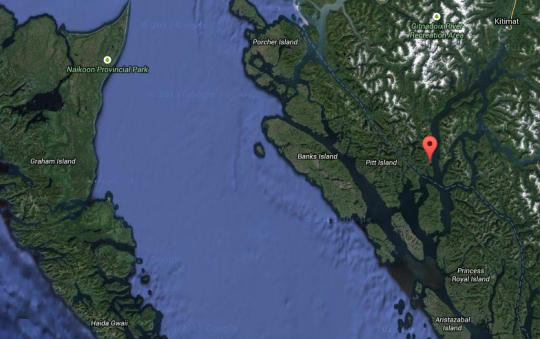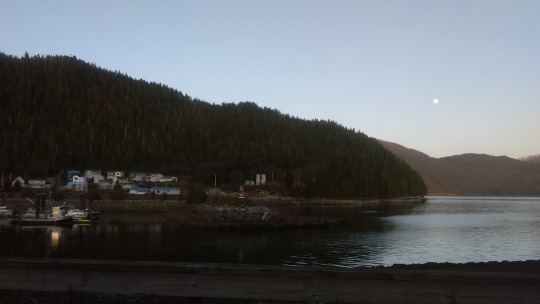by Cassandra Lamontagne
My Master’s research examines the climate changes taking place in the territory of the Gitga’ata First Nation, situated in coastal British Columbia. The Gitga’ata are a community with over 700 members whose village is called Hartley Bay. Of the population, only about 135 live in Hartley Bay. The others live primarily in urban areas such as Vancouver or Prince Rupert.

The Gitga’ata are accustomed to relying on their traditional lands and waters, as well as a mix of ancestral and modern harvesting techniques, for their foods and some of their medicines. Many fish for salmon and herring, and they have a Coho hatchery where they foster the birth and survival of Coho in their streams to encourage high returns. An annual seaweed harvest takes place every spring to collect and dry porphyra abbottae, an edible seaweed. Cockles and clams are collected from the intertidal zone. Berries are gathered during the late summer and fall.
Some of the Gitga’ata have told me that their ancestors harvested these foods in just the same manner, at the same time every year, unless there was a year with strange weather, drought or flooding. Many of the community, who have been able to rely on the seasonal progression of harvest for their entire lives, are finding that the previously predictable patterns of weather during harvesting season are changing. Furthermore, the phenological timing, abundance, quality, or behavior of their marine and land resources are also altered. There are many people with these concerns and observations, and the Gitga’ata are proponents of their own Climate Change Adaptation Plan, funded by the AANDC. There is interest in the community to draw together all knowledge of these changes and to use it to inform adaptation planning, justify the delivery of critical infrastructure, and create a baseline for monitoring.
For my project, I aim to:
1. Collaborate with Gitga’ata partners in interviews concerning community observations of change
2. Help to document and synthesize a remarkable body of community environmental knowledge
3. Highlight the value of Gitga’ata knowledge of their territory and the changes taking place
4. Depict the real impacts of climate change on the territory of a single community using community observations of change as well as
downscaled historical climate data
5. Provide Gitga’ata with supplemental climate change information from climate models, weather records, satellite data, etc.
The fieldwork component of my research was to conduct interviews with knowledgable Gitga’ata community members in Hartley Bay and Prince Rupert about their experience with their territory and how environmental variables have changed in their lifetimes. Our discussion of environmental change was not limited to direct observations of weather, but included such physical changes as sea level rise or a shift in abundance, distribution, or harvesting of plant, animal, and marine species.
The first evening (March 1st) was dedicated to presenting at the Community Meeting in Prince Rupert, where I met many members of the community, who were all really nice and some with wicked senses of humor! I outlined my research and received feedback, as well as a list of volunteers.
Accessible only by float plane or by ferry, Hartley Bay is the main settlement of the Gitga’ata in their territory. I travelled to Hartley Bay on March 2nd by ferry and I stayed with Clare Haeis Hill at his lovely bed & breakfast (the Squirrel’s Den Inn) for 6 days. On the first night in Hartley Bay I attended their community meeting and dinner. It was very nice to chat with some of the Elders and to get to know Spencer, a member of the community who is researching Gitga’ata Land Use and Title and who I collaborated with in my field work. It was also nice to have so much time with Nancy Turner, a very talented ethnobotanist, member of my thesis committee, and mentor, who had introduced me to the Gitga’ata originally.

Over the next 6 days, I accompanied the school children on two of their educational outings to the lake, where they developed their videography skills under the watchful of their teacher Jeremy as they interviewed my fellow researchers about their knowledge of the forest’s plants, animals, and cultural history. I took many walks around the village and paid visits with Nancy Turner, Spencer, and Dana Lepofsky, an archaeologist at Simon Fraser. Hartley Bay is incredible and the Gitga’ata members were all so welcoming, it was a real pleasure and privilege for me to meet them.
I participated in 8 interviews with community members. Most of these interviews lasted 1-2 hours and took place in the participants’ homes, though two took place in the Band Office and one along the boardwalk which leads from the Coho hatchery up to the lake.

Some were interviewed in pairs rather than alone. Participants told me stories of their time spent as youngsters at the spring seaweed harvesting camp of K’Yel, or their summer weeks spent harvesting herring at Old Town, the ancestral village of the Gitga’ata. People talked about changing rain behavior, different storms, winters without snow, shifting deer patterns, and many other concerns and observations.
My interaction with community members in Prince Rupert was mostly limited to interviews, which took place on average once a day during my 7 days in town, for a total of 7 participants. A few were interviewed in their homes or places of work, but most were interviewed in a private room at the library of Northwest Community College. Some used maps of Gitga’ata territory to show the places that they were describing and what happened there. In my free time, I organized my notes and took long walks through Prince Rupert, and got to know Andrea who runs the beautiful Tall Trees Inn that I stayed at for the week.
I learned so much and had a great time talking with each new person.
My fieldwork was an incredibly special time that enabled me to experience BC in a way that few get to experience it; to make friends with people who were kind, welcoming and incredibly smart; to learn crucial lessons from them that extend far beyond a “climate change impacts” data collection project; and to do it all without worrying how I’m going to make rent the following few months. Thanks to QCBS, who offered me their Student Excellence Award. Along with additional funds from NSTP, it made my two weeks in the Great Bear Rainforest possible.

0 Comments